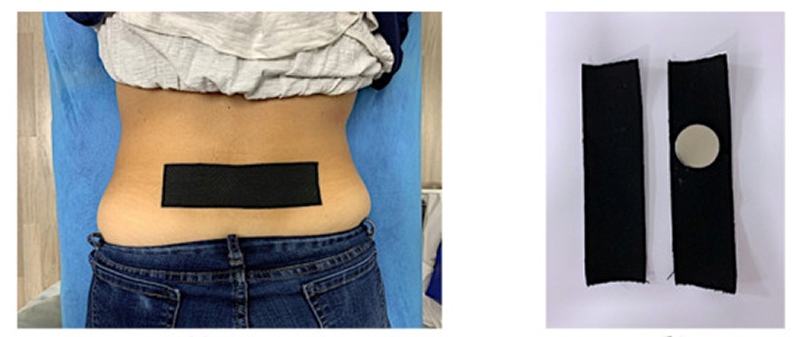Back pain management: the attraction of magnetism

SPB looks at some fascinating new research on the use of magnetic taping in the treatment of lower back pain
Any athlete (including the author of this article!) who has ever suffered from chronic low back pain (CLBP) understands how debilitating it can be. Indeed, data shows that CLBP is one of the main reasons for loss of physical function in otherwise healthy adults, resulting in job absenteeism and decreased quality of life(1,2). Studies reveal that 60% to 80% of the general population experiences CLBP at some point in their lifetime(3), and despite their level of fitness, athletes are no exception. Indeed, even elite cyclists show an incidence of back pain similar to the general population(4).Costs of back pain
For athletes, the cost of CLBP is in missed training days, missed competitions, missed opportunities for selection and generally getting frustrated. An athlete may be used to training around limb injuries but a back injury is extremely debilitating. Light activity and movement is about all that can be performed when suffering from acute back pain or spasms, and even that may not be possible. To complicate matters further, doing nothing at all is not a good route to recovery from CLBP, and the continuation of normal daily activities is now recommended by medical practitioners for those patients with non-specific CLBP(5). This is preferred to bed rest, which has not been shown to have a positive effect.In order to overcome CLBP while maintaining a degree of activity, some kind of pain relief is often recommended in the rehabilitation of patients with low-back pain, which allows patients to begin rehab exercises sooner(6). This pain relief typically involves NSAID medications such as Ibuprofen or Naproxen. However, these anti-inflammatory drugs come with their own drawbacks and side effects – see this article for an in-depth discussion on the pros and cons of NSAIDs.
Magnetism and pain
One alternative to pain medication is the use of magnets. Although considered a bit ‘leftfield’, there is in fact a good deal of research demonstrating that static magnetic fields can positively influence human tissue and result in several therapeutic effects, such as pain relief, bone regeneration, muscle regeneration, improved nerve functioning, and improvement in tissue blood flow(7-10). Historically, static magnetic field therapy has been used to control pain, but the mechanism by which it reduces pain is unclear and there are a number of theories:- A first theory is that magnetic field placed in proximity to nerve fibers associated with pain signals changes the ‘resting membrane potential’ in these fibers, making them less likely to be ‘fired’ – ie transmit pain signals(11).
- A second theory suggests that magnetic fields promote increased blood flow through the skin, subcutaneous tissue, muscle tissue, and ligament tissues, reducing the accumulation of inflammatory compounds in the vicinity of the injured tissue(12).
- A third theory suggests that magnetic fields affect the way that ions (atoms and molecule fragments carrying an electrical charge) bind to key cells, thus controlling the release of inflammatory compounds such as cytokines(13).
To put this theory to the test, a new study carried out by Spanish researchers has investigated the effect of Magnetic Tape® with magnetic nanoparticles applied to the lower lumbar area in subjects with low-back pain(14). In particular, the study, which was published in the journal ‘Sensors’ sought to discover if the Magnetic Tape had an immediate effect on pain experienced at various points along the spine, and whether blood flow to the lower limbs was increased by the Magnetic Tape.
The research
In this study, 22 subjects with chronic low-back pain (as diagnosed by a medical doctor) and with no other health conditions were recruited. The subjects were randomized to two groups:- Taped with Magnetic Tape
- Taped with standard Kinesio tape (no magnetic properties) as regularly used by physios
Figure 1: Location of tape application

Left: location of tape position; right: both tapes had identical appearance apart from the magnetism in the Magnetic Tape (shown here by its ability to attract a magnetic disc).
Before and after the tape application, Doppler Ultrasound was carried out on all the subjects to measure the blood flow to the legs via the femoral artery. In addition, the ‘pain pressure threshold’ was also tested before and after tape application. In this test, the subjects lay in the prone position while increasing force was applied at various points along the lumbar and sacral spine with an algometer – an adjustable pressure-inducing device using a 1cm2 surface area. The force at which pain was eventually perceived at these points along the spine was recorded for both tapes.
The findings
Following the application of the tapes, there was a significant increase in the pain pressure threshold in the magnetic tape subjects. In other words, the Magnetic Tape subjects became less sensitive to pain and could tolerate more pressure before experiencing pain. Even better, the reduced sensitivity to pain occurred at multiple points in the lumber and sacral spine, from L1 all the way down to S4 (see figure 2). In addition to reduced pain levels, Doppler Ultrasound revealed that the subjects taped with Magnetic Tape experienced an increased blood flow to the lower limbs of between 20-40%, suggesting that the static magnetic field had significantly modified blood flow in the region.Figure 2: Lumbar and sacral vertebrae pain measures

Compared to standard tape, the magnetic tape produced reductions in pain sensitivity in the lower spine, from L1 to S4.
Practical implications
The data from this study may seem surprising but are in fact consistent with that from other studies, which have found that static magnetic fields applied to the skin can significantly reduce pain(7) and improve vascular blood flow in the area(15). The obvious take home message is that the use of Magnetic Tape could well offer athletes, coaches, sports clinicians and physios a useful alternative tool to pain relief for reducing back pain so as to enable the process of rehab to begin as early as possible, without the drawbacks of pain medication. And where standard Kinesio taping is used, magnetic Kinesio tape may offer additional advantages. At the time of writing, Kinesio tape incorporating magnetic nanoparticles such as ‘Magnetic Tape®’ discussed in this study is a relatively new development, and as such is, not widely available. However, it can be purchased online in Europe – for example from these distributors:- www.fisaude.de/elastischer-klebeband-magnetband-enthalt-magnetische-nanopartikel-um-die-therapeutischen-wirkungen-zu-vervielfachen-maSse-mx-cm-p-50738.html
- www.tiendafisioterapia.com/kinesiotape-vendaje-neuromuscular/800-magnetic-tape-5cm-x-5m
References
- 2016 Oct 8; 388(10053):1545-1602
- 2018 Jun 9; 391(10137):2384-2388
- Curr Sports Med Rep, 2004 Feb;3(1):35-40
- Br J Sports Med, 1996;30:349-353
- Physical Therapy. 2001; 81, p1641-74
- J Back Musculoskelet Rehabil. 2020; 33(6):953-959
- J. Obstet. Gynecol. 2002;187:1581–1587
- 2007;28:81–98
- Orthop. Transl. 2020;25:87–95
- Healthc. Mater. 2018;7 doi: 10.1002/adhm.201700845
- 1991; 12(2):71-5
- Rheum Dis Clin North Am. 2000 Feb; 26(1):51-62, viii
- J Back Musculoskelet Rehabil. 2018; 31(6):1065-1073
- Sensors (Basel). 2021 Oct; 21(19): 6517
- 2003; 207(1):10-4
You need to be logged in to continue reading.
Please register for limited access or take a 30-day risk-free trial of Sports Performance Bulletin to experience the full benefits of a subscription. TAKE A RISK-FREE TRIAL
TAKE A RISK-FREE TRIAL
Newsletter Sign Up
Testimonials
Dr. Alexandra Fandetti-Robin, Back & Body Chiropractic
Elspeth Cowell MSCh DpodM SRCh HCPC reg
William Hunter, Nuffield Health
Newsletter Sign Up
Coaches Testimonials
Dr. Alexandra Fandetti-Robin, Back & Body Chiropractic
Elspeth Cowell MSCh DpodM SRCh HCPC reg
William Hunter, Nuffield Health
Keep up with latest sports science research and apply it to maximize performance
Today you have the chance to join a group of athletes, and sports coaches/trainers who all have something special in common...
They use the latest research to improve performance for themselves and their clients - both athletes and sports teams - with help from global specialists in the fields of sports science, sports medicine and sports psychology.
They do this by reading Sports Performance Bulletin, an easy-to-digest but serious-minded journal dedicated to high performance sports. SPB offers a wealth of information and insight into the latest research, in an easily-accessible and understood format, along with a wealth of practical recommendations.
*includes 3 coaching manuals
Get Inspired
All the latest techniques and approaches
Sports Performance Bulletin helps dedicated endurance athletes improve their performance. Sense-checking the latest sports science research, and sourcing evidence and case studies to support findings, Sports Performance Bulletin turns proven insights into easily digestible practical advice. Supporting athletes, coaches and professionals who wish to ensure their guidance and programmes are kept right up to date and based on credible science.









